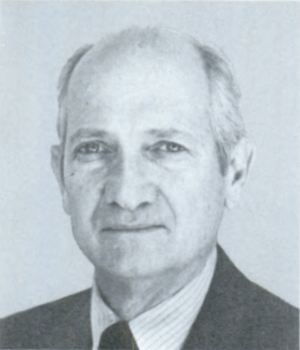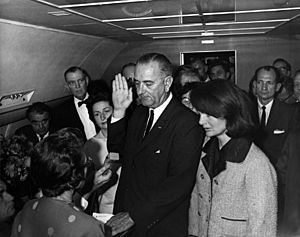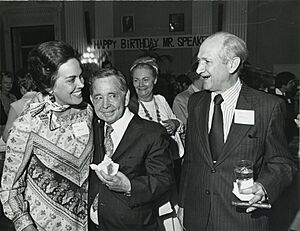Jack Brooks (American politician) facts for kids
Quick facts for kids
Jack Brooks
|
|
|---|---|
 |
|
| Chair of the House Judiciary Committee | |
| In office January 3, 1989 – January 3, 1995 |
|
| Preceded by | Peter W. Rodino |
| Succeeded by | Henry Hyde |
| Chair of the House Government Operations Committee | |
| In office January 3, 1975 – January 3, 1989 |
|
| Preceded by | Chester E. Holifield |
| Succeeded by | John Conyers (Oversight Committee) |
| Member of the U.S. House of Representatives from Texas |
|
| In office January 3, 1953 – January 3, 1995 |
|
| Preceded by | Jesse M. Combs |
| Succeeded by | Steve Stockman |
| Constituency | 2nd district (1953–1967) 9th district (1967–1995) |
| Member of the Texas House of Representatives from District 16-1 |
|
| In office January 1947 – January 1951 |
|
| Preceded by | William Smith |
| Succeeded by | William Ross |
| Personal details | |
| Born |
Jack Bascom Brooks
December 18, 1922 Crowley, Louisiana, U.S. |
| Died | December 4, 2012 (aged 89) Beaumont, Texas, U.S. |
| Political party | Democratic |
| Spouse |
Charlotte Collins
(m. 1960) |
| Children | 3 |
| Education | University of Texas at Austin (BA, LLB) |
| Military service | |
| Allegiance | |
| Branch/service | |
| Rank | |
| Battles/wars | World War II |
Jack Bascom Brooks (December 18, 1922 – December 4, 2012) was an American politician from Texas. He was a member of the Democratic Party. Brooks served for 42 years in the United States House of Representatives. This is where laws are made for the whole country. He represented Texas from 1953 to 1995.
Brooks had strong connections with other important Texas Democrats. These included Speaker of the House Sam Rayburn and President Lyndon B. Johnson. For more than 15 years, he was the most senior member of the Texas group in Congress.
Contents
Jack Brooks's Early Life and Education
Jack Brooks was born in Crowley, Louisiana, on December 18, 1922. When he was five, his family moved to Beaumont, Texas. His father, who sold rice, died when Jack was 13. To help his family, young Jack worked as a carhop and a newspaper reporter.
In 1939, he received a scholarship and went to Lamar Junior College. After two years, he transferred to the University of Texas at Austin. He earned a degree in journalism in 1943.
Military Service During World War II
Jack Brooks joined the U.S. Marine Corps during World War II. He served for about two years in the Pacific Ocean. He fought in important battles on islands like Guadalcanal, Guam, and Okinawa. He also served in North China.
He reached the rank of first lieutenant. After the war, he stayed in the Marine Corps Reserve. He retired in 1972 as a colonel.
Jack Brooks's Political Career
Serving in the Texas State Legislature
Jack Brooks was a lifelong member of the Democratic Party. In 1946, he was elected to represent Jefferson County in the Texas House of Representatives. This is where state laws are made.
While in the state legislature, he worked to change Lamar Junior College into a four-year university. His bill first failed but passed the next year. Today, this school is known as Lamar University. Brooks was re-elected to the state legislature in 1948 without anyone running against him. The next year, he earned a law degree from the University of Texas Law School.
Joining the U.S. Congress
After four years in the Texas legislature, Brooks ran for the U.S. House of Representatives. He won a tough primary election with 12 candidates. Then he was elected to Congress in the 1952 election.
Brooks was supported by other powerful Texans like House Speaker Sam Rayburn and U.S. Senator Lyndon B. Johnson. He held some conservative views, for example, on the death penalty and gun control. But he was more liberal on other issues, like government spending, workers' rights, and civil rights.
In 1956, he chose not to sign the Southern Manifesto. This was a statement that opposed racial integration in public places. He voted against some early civil rights laws in 1957 and 1960. However, he voted for the 24th Amendment (which banned poll taxes). He also voted for the important Civil Rights Acts of 1964 and 1968, and the Voting Rights Act of 1965. As a member of the House Judiciary Committee, he helped write the 1964 and 1965 laws.

On November 22, 1963, Brooks was in President John F. Kennedy's motorcade in Dallas. This was when President Kennedy was assassinated. Hours later, Brooks was on Air Force One when Lyndon B. Johnson became president.
In 1966, the boundaries of his district were changed. This happened after the Supreme Court ruled that congressional districts should have similar populations.
Key Laws and Leadership Roles
One of Brooks's most important laws was the Brooks Act. This law, passed in 1972, required the government to get competitive bids for federal computer contracts. It was the main rule for buying computers for the government for 30 years. Many say it helped technology advance.
As a member of the House Judiciary Committee, Brooks was involved in the process to remove President Richard Nixon from office in 1973–74. He helped draft the articles of impeachment. Nixon later called Brooks his "executioner" because of his role. Brooks was one of eight representatives who voted for all five articles of impeachment against Nixon.

Brooks led two important committees in the U.S. House. He was chairman of the U.S. House Committee on Government Operations from 1975 to 1988. Then he chaired the U.S. House Committee on the Judiciary from 1989 to 1995. He also served on other special committees. In 1979, he became the most senior member of the Texas group in Congress, a position he held for 15 years.
As leader of the Government Operations Committee, Brooks helped pass several laws. These laws improved how the government managed its money and agencies. They included the Inspector General Act of 1978 and the Paper Reduction Act of 1980.
In 1988, Brooks showed his influence in trade policy. He introduced a change to a spending bill that stopped Japanese companies from working on U.S. public projects for one year. He said this was because Japan seemed to be unfair to U.S. companies.
Brooks also served as a House impeachment manager twice. This means he helped present the cases against federal judges Alcee Hastings and Walter Nixon in their impeachment trials in 1989.
While leading the House Judiciary Committee, Brooks supported several major laws. These included the Americans with Disabilities Act of 1990, which protects people with disabilities. He also supported the Omnibus Crime Control Act of 1991 and the Civil Rights Act of 1991. He was also a supporter of the 1994 Violent Crime Control and Law Enforcement Act. This law included a ban on assault weapons, which he actually opposed.
Brooks won re-election in 1992. However, in 1994, he unexpectedly lost to Steve Stockman. Brooks had served 21 terms. He became the most senior representative ever to lose a general election. His time in Congress spanned the presidencies of 10 U.S. presidents.
Jack Brooks's Personal Life
In 1960, Jack Brooks married Charlotte Collins. They had three children: Jeb, Kate, and Kimberly. Jack Brooks passed away at Baptist Hospital in Beaumont on December 4, 2012, at the age of 89.
Legacies and Tributes to Jack Brooks
Jack Brooks is remembered in many ways:
- In 1978, a U.S. courthouse and post office in Beaumont, Texas, were named the Jack Brooks Federal Building.
- A park in Galveston County is named Jack Brooks Park.
- In 1989, a statue of Brooks was placed at Lamar University in Beaumont.
- In 2001, NASA gave him its Distinguished Service Medal. This was for his strong support of the U.S. space program. NASA said he helped strengthen the agency and supported the International Space Station.
- In 2010, the Southeast Texas Regional Airport was renamed Jack Brooks Regional Airport in his honor.
- In the 2016 movie Jackie, an actor played Jack Brooks.
See also
- Politics of Texas
- Gun law in the United States

